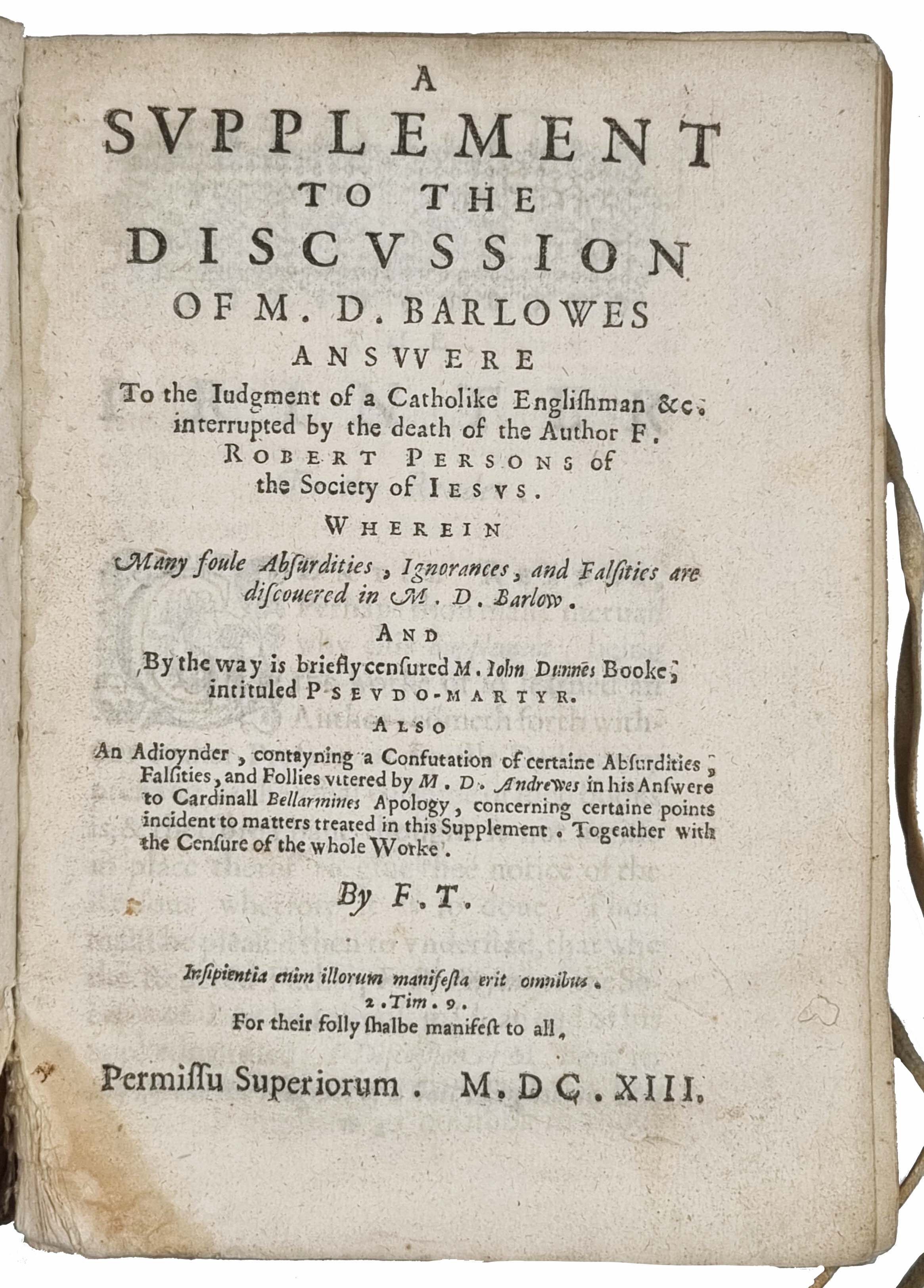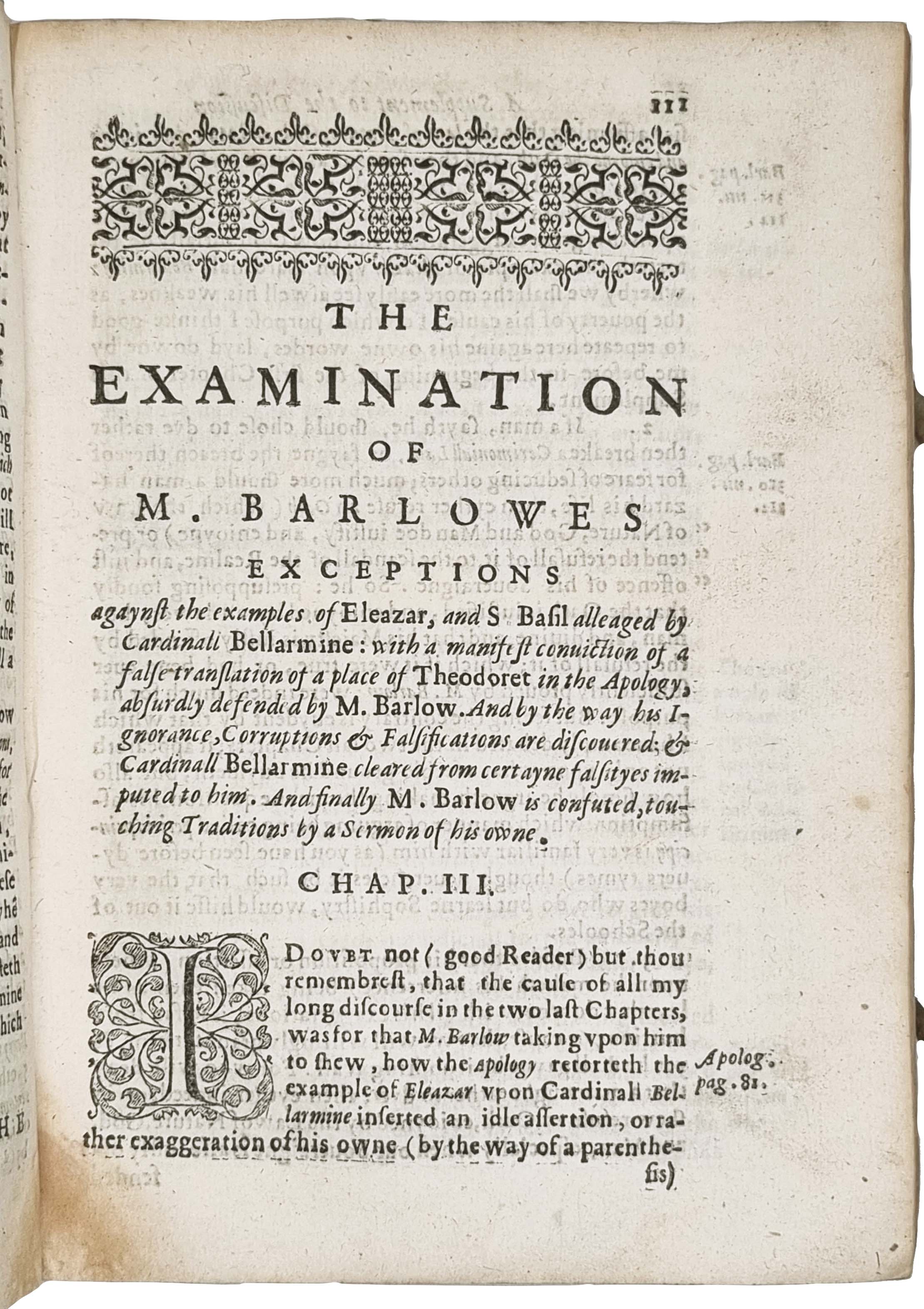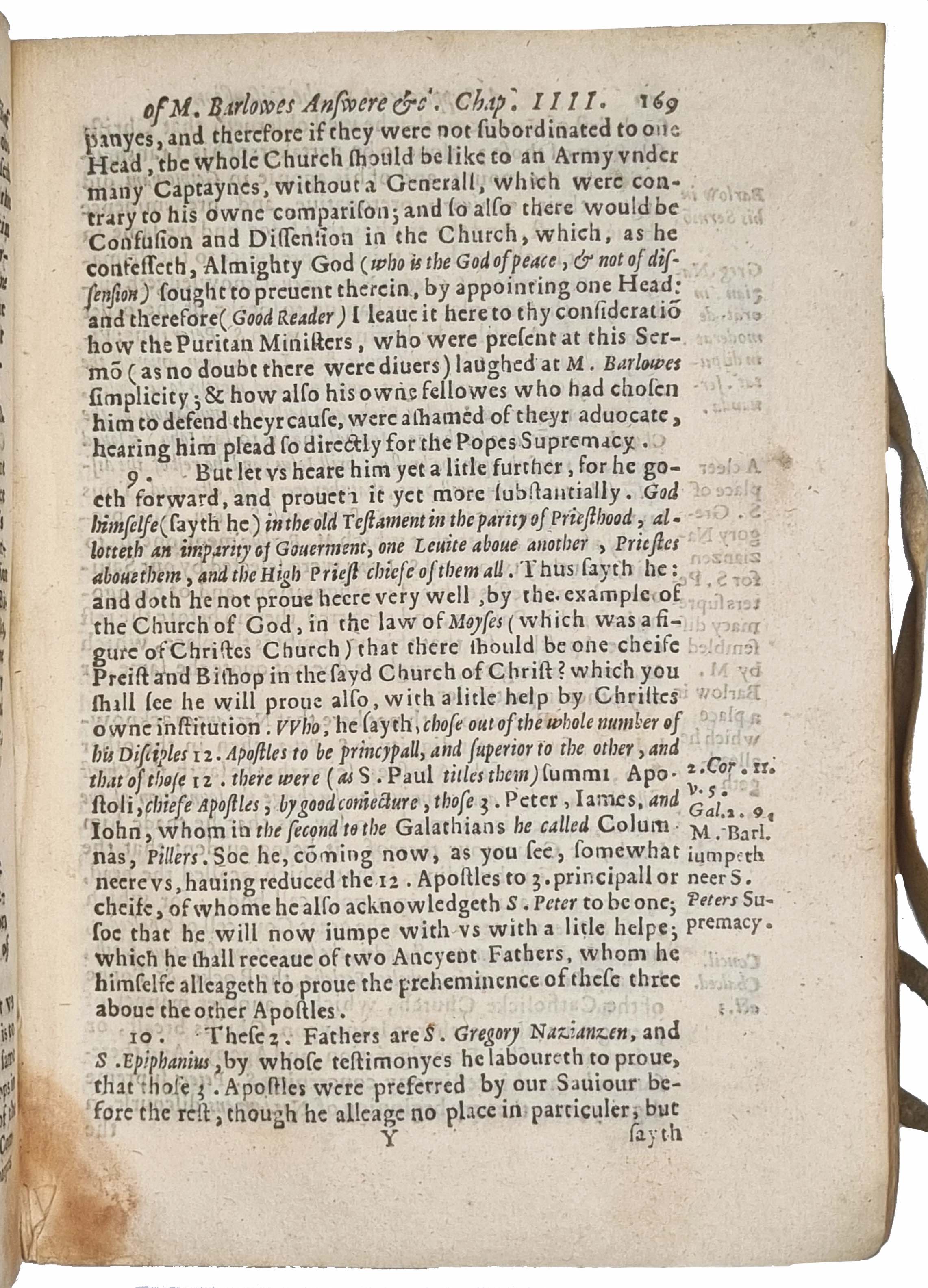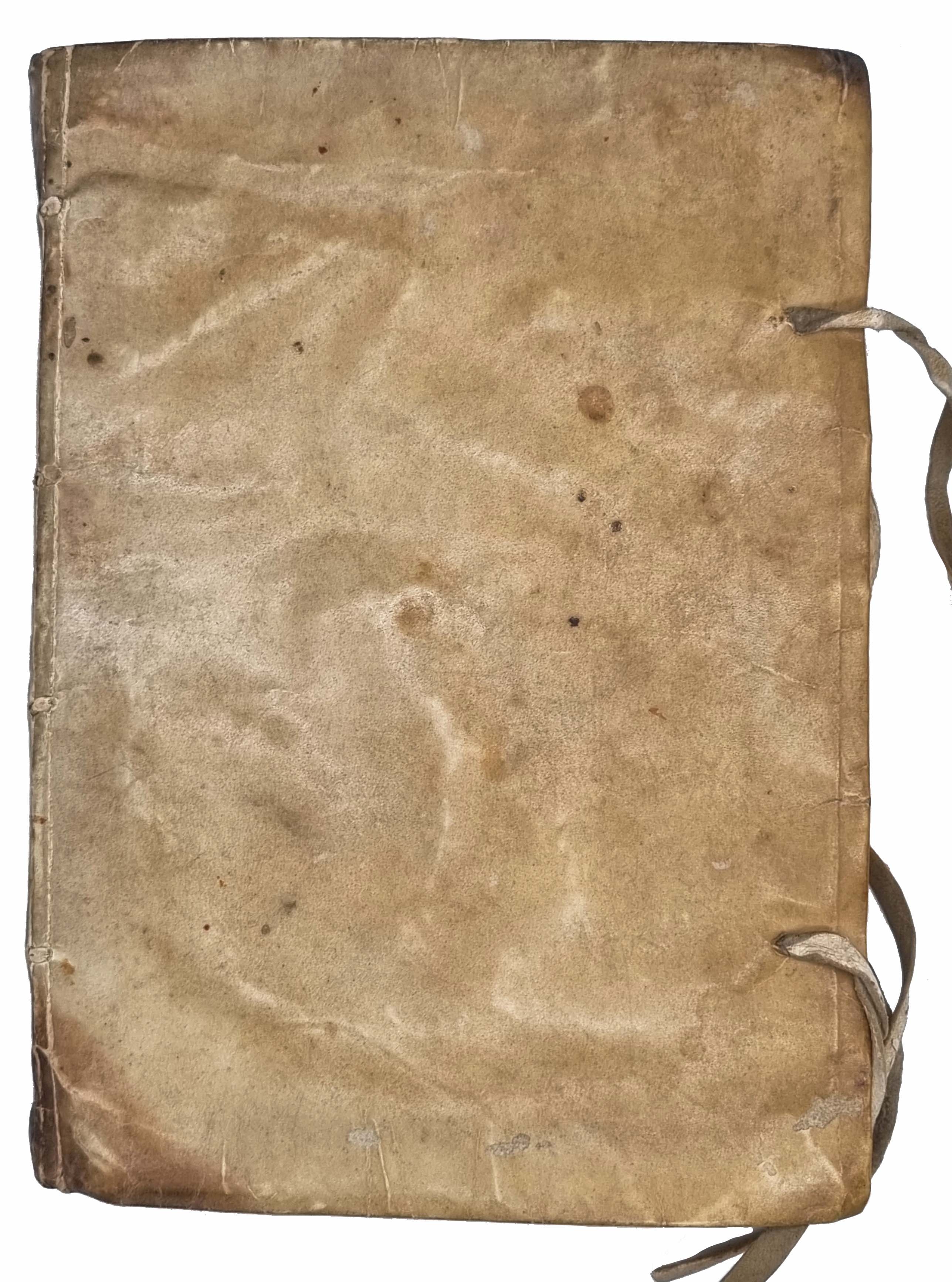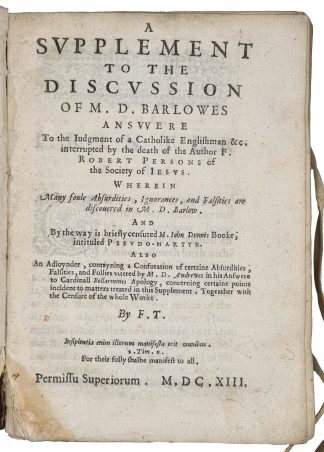FITZHERBERT, Thomas
A supplement to the discussion of M. D. Barlowes ansvvere to the Iudgment of a Catholike Englishman
[Saint-Omer], printed at the English College Press] Permissu superiorum, 1613£3,750.00
FIRST EDITION. 4to pp. [viii], 400, [viii]. * , A-3E , last blank. Roman letter some Italic. Floriated woodcut initials, typographical headpieces, early autograph on fly in a near contemporary English hand (Ames?), note at head of pastedown referencing page 48, a contemporary hand has added to the errata list on the final leaf, correcting ‘our visible’ to ‘one visible’ and has made the correction in the text, engraved bookplate of Robert S Pirie on pastedown, his notes in pencil concerning the section of John Donne and the works scarcity. Light age yellowing small waterstain to lower inner corner not affecting text, title and following leaf with small hole to blank fore-margin. A fine copy in excellent contemporary limp vellum with ties.
Extremely rare first edition of this important controversial work by the English Jesuit Thomas Fitzherbert, printed at the Jesuit College at St. Omer. Fitzherbert was the heir of a distinguished recusant family, the grandson of the noted jurist Sir Anthony Fitzherbert and a zealous defender of English Catholicism. In 1572, aged 20, he was imprisoned for recusancy and on release became acquainted with Parsons and Campion. In 1588 on the death of his wife, he removed to Spain and was active in the affairs of Catholic exiles and at one point charged with conspiracy to poison Queen Elizabeth. He was in fact closely watched by Elizabeth’s spies and his name recurs in the state papers of the period. In 1601 he was ordained priest, acted for twelve years as the agent in Rome of the English clergy and in 1613 joined the Society of Jesus. He was successively superior of the English mission at Brussels and rector of the English college at Rome, remaining en poste almost until his death in 1640, at the remarkable age of 88, “an object of admiration and esteem, not only of Catholics, but even for those who differed from him in religion” Gillow II p. 285.
“In 1613, the Jesuit, Thomas Fitzherbert published one of a series of works attacking Andrewe’s response to Bellarmine. Just as the earlier debate between Cranmer and Gardiner hinged in part on their reading of Origen, here too the reading of an Eastern Church Father was contested – in this case, John Chrysostom. Bellarmine had claimed that Chrysostom ‘approved the veneration of holy relics’, citing his exhortation: ‘let us with great faith touch their reliques, to the end we may obtayne some benediction thereby’. Andrews argued in response that Bellarmine was guilty of a mistranslation: ‘For in the Greeke ‘ ’, is to touch the shyrne; but to touch the shrine, I thinke, is not to adore it’. Fitzherbert wastes no time in accusing Andrews of small-minded pedantry in his response: ‘Doth he not therin shew himselfe to be a meere tryfler, caviller, and wrangler?’ Andrews, Fitzherbert claims, is guilty of ‘cavilling only about a word, or two, as if all the wyght, and force of the place consisted therin’. Nonetheless, he attempts to debate Andrews on his terms, arguing that, as Bellarmine suggests, ‘the Greeke word ‘ ’.. although it do properly signify tangere, to touch, yet it includeth many tymes and act of veneration, or worship, yea sometimes of prayer’. These verbs suggest worshipful touch, not mere neutral contact. Interestingly, his evidence for this claim is based not only on Christian sources but upon the ‘ancient kind of adoration with the hand, used among Paynims’, and he cites lines from Homer, Euripides and other ancient authors for his defence. … Fitzherbert (also) enlisted a series of Roman writers as witness to his claim that the verb tangere could imply specifically worshipful contact, including Pliny’s description of the touching of knees and chins by supplicants, and Virgil and Ovid on the touching of alters and tables when swearing an oath or praying. Most remarkably he quotes three lines from De Rerum Natura – a striking incursion of a supposedly atheistical poem into the midst of theological debate – to the effect ‘that the images of the Gods standing at the gates, had their right hands worne with the frequent touching of passengers’.” … The immense theological and intellectual stakes involved in grammatical interpretation had throughout the Reformation created a burgeoning awareness of the differences grammatical systems and the difficulty of reconciling them.” Joe Moshenska ‘Feeling Pleasures: The Sense of Touch in Renaissance England.’ Besides further criticism of Barlow he also attacked John Donne’s Pseudo-Martyr, which had been published in 1610 to persuade Catholics to take the ‘Oath of Allegeance.’
“The well-known Jesuit college at St. Omer was founded by Father Parsons in 1592 or 1593. All Catholic education having been prohibited in England, several colleges had been founded by Englishmen on the Continent — at Douai, Rome, and Valladolid; their primary object was the education of the clergy. Father Parsons recognized the need of a college intended in the first instance for the laity, and for this purpose he chose a spot as near as possible to England. St. Omer was twenty-four miles from Calais.” Catholic Encyclopaedia. The printing press was set up a the College in 1608
STC 11021; ESTC S102262. “In support of “A discussion of the answere of M. William Barlow, D. of Divinity, to the booke intituled: The judgment of a Catholike Englishman living in banishment for his religion &c.” and “The judgment of a Catholicke English-man, living in banishment for his religion” by Robert Parsons, against “An answer to a Catholike English-man” by William Barlow; also an answer to “Pseudo-martyr” by John Donne. The adjoinder to Lancelot Andrewes’s “Responsio ad apologiam Cardinalis Bellarmini, quam nuper edidit contra praefationem monitoriam” was actually published separately in STC 11022”. Allison & Rogers. II 287. Milward 369.In stock


